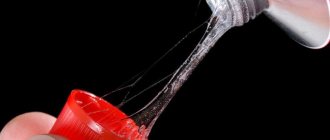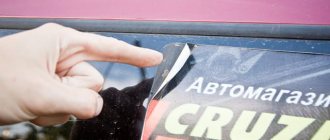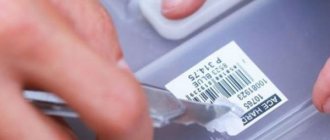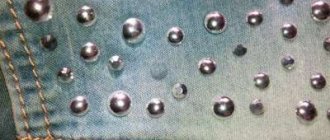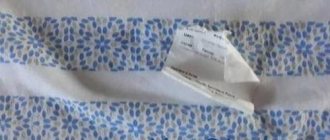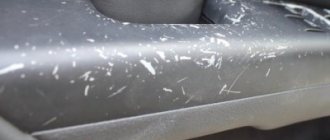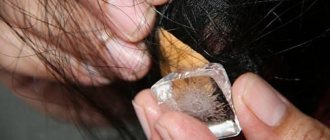The polyvinyl acetate composition gives good results when gluing various surfaces, so getting it on the fabric can lead to damage to the item.
To effectively deal with unwanted traces, you can use home recipes or use special products.
In this article we will tell you how to remove PVA glue from clothes at home.
How to remove fresh stains?
It is easiest to deal with a fresh stain when a white drop has not yet hardened on the surface of the fabric. In this case, you will have to act quite quickly. The method of getting rid of contamination should take into account the composition of the glue.
of PVA are:
- water emulsion of polyvinyl acetate;
- plasticizing additives.
Washing procedure:
Remove the bulk of the glue from the material with a napkin or rag. You need to work with blotting movements so as not to smear the stain even more.- If possible, remove any remaining product with a sharp tool using scraping movements, moving from the edges to the center. It is better not to experiment with such processing with delicate materials.
- Hold the stained area of fabric under running water, directing it so that the stain is washed.
- In a separate container, dilute the detergent (gel, grated laundry soap or powder) in warm water.
- Dip the item into the washing solution.
- Leave for about half an hour.
- Rub the affected area.
- Wash the product in any convenient way.
Intense exposure should be avoided so as not to damage the tissue itself.
The most common tips for removing glue
One of the first places is acetone, which does its job perfectly. In addition to this, you can use paint thinners, but it is better not to use this method for dyed things - the bright design will come off right away.
Some use gasoline
It is important to know here that the method is effective, but requires additional effort, namely: after it you have to wash off greasy stains with strong powders
To effectively remove stubborn stains, use vinegar. Acid will corrode any glue, especially superglue, and your item will look like new.
Stationery glue has a lighter structure, so only a stream of hot water will be enough for it. The glue will quickly swell and come off with the help of liquid. And the remains are easily removed with a brush.
One sure way is freezing. We put the damaged item in the freezer and wait for a while. The glue will freeze and can be easily removed with a brush.
You can use the opposite option - heat. To do this, place napkins on both sides of the problem area so that the stain is completely covered. We iron it and watch how the glue remains on the surface of the napkin. This is done several times.
With very thin fabrics, such as chiffon, the vinegar solution will remove the glue. Just add it when washing and turn on the washing machine. Large stains cannot be removed this way, but small droplets of glue will come off and leave no traces.
Office glue can be easily removed with alcohol. Soak cotton wool in it and apply for half an hour.
Another important assistant will be “anti-glue”, which is easy to purchase in stores. It effectively removes all types of glue. It is only advisable to carefully study the instructions before doing this.
Top 3 special tools
In some situations, homemade recipes may not help . Then special drugs will come to the rescue.
Grass Antigraffiti
This product, Grass Antigraffiti, is an effective product for removing traces of glue, chewing gum, tape, etc.
It contains:
- surfactant;
- organic solvents and other components.
Use Grass Antigraffiti for manual cleaning in undiluted form, simply moistening the stained area with it. After leaving it on the fabric for just a few seconds, the stain will rub slightly. After this, the product is washed.
The cost of a 0.6 liter bottle. with a sprayer - about 300 rubles. The drug is also available in 5 kg canisters.
Advantages:
- efficiency;
- economical consumption;
- affordable price for a fairly large volume.
Flaws:
- strong unpleasant odor;
- may damage the material;
- It does not cope with all traces of glue on fabric.
Duty Universal
The product is a professional remover of glue and adhesive base of stickers, tape, etc. The product has an enhanced effect and is produced in Russia.
Compound:
- Non-ionic surfactants – 5%;
- isobutane;
- D-limonene;
- organic compounds.
The product is easy to use: it is sprayed onto the stained area, then left for a couple of minutes and the material is cleaned. The processing is completed by washing. Price for volume 0.4 l. – from 350 rubles.
Advantages:
- efficiency;
- ease of use;
- may damage the surface of the material;
- quick results;
- no effort required;
- copes well with old marks;
- good volume.
Minuses:
- pronounced strong odor;
- sometimes re-processing is required.
Mellerud
The 0.25 l bottle is produced in Germany.
The product allows you to deal with traces of glue, as well as other stains - lipstick stains, ink, etc. Price – 450 rubles. How to use:
- Soak a napkin in Mellerud.
- Moisten the stain area.
- After the reaction has passed, the remaining glue can be cleaned off.
- Rinse the surface of the material under water and wash as usual.
The product has good reviews. Its disadvantage is the high cost for a small volume and the need in some cases to repeat the processing.
Freezing
Since PVA is a water-based glue, when exposed to low temperatures it freezes, becoming brittle. One of the proven ways to clean clothes:
- Place clothes stained with glue in the freezer for an hour or two.
- Break the dried construction PVA with a hammer, gradually collecting the broken pieces
- Scrape off any remaining glue with a knife and brush off with a clothes brush.
- Remove remaining stains using ammonia.
- You can wash clothes from glue in soapy water.
Recommendations
you deal with the problem of traces of PVA glue on clothes :
- Solvents that are aggressive in their effects can damage fabric fibers, so their use should be limited and only used when other methods have failed.
- When removing stains, especially those involving chemicals, it is best to wear rubber gloves.
- The longer the stain remains on the material, the more difficult it will be to remove.
- The technology for cleaning an item should take into account the type of fabric, its color, the presence of decor, etc.
Useful information on how to remove traces of glue from clothes is in this section.
Removing PVA from different types of fabric
The task of removing stains of PVA glue or other compounds is complicated by the fact that it is impossible to use a certain method for any fabric.
You should take into account the material from which the clothing is made, and only then choose a product to remove the stain.
PVA can be removed from linen or cotton fabric with alcohol. Denim clothing can easily withstand treatment with nail polish remover or gasoline. A suede item should first be exposed to hot air or steam, and then remove traces with ammonia.
For delicate fabrics and silk, the solvent is very dangerous, so in this case the freezer will come to the rescue, in which you should keep the item for about two hours, then remove the adhesive with a nail file. Or mix vinegar and ammonia in equal quantities and rub the contaminated area with this solution.
A stain left on a woolen item can be removed with 20 g dissolved in 100 ml of water. citric acid. After applying this product to the fabric, the item should be washed.
When a PVA stain is placed on a fur item, you should use a simple soap solution. To restore its former shine, treat the fur with vinegar water.
If these methods did not lead to the desired result, or after active manipulation the fabric was damaged, save the situation with an original patch or sticker. With a quick response, the item can still be washed.
Reasons for the appearance of glue stains on wallpaper
Unfortunately, it is not always possible to avoid such a problem as the appearance of glue stains on the surface of the wallpaper. Stains can occur if, before gluing, the wall was not properly prepared for the new coating, that is, glue residues from previous paintings were not removed. In the case of plasterboard walls, complete puttying is required. Also, putty is indispensable if the wall has lime stains. This substance can react with wallpaper glue and cause yellow spots on the finished covering that cannot be removed in any way.
The walls must be completely ready for wallpapering, that is, covered with a primer and puttied. It is imperative to wait for the applied ready-made solutions to dry completely, so that stains and unnecessary smudges do not appear in the future. Sometimes a situation may arise that results in a reaction of an old, not completely removed substance with a new one. To prevent this from happening, the walls must be cleaned as thoroughly as possible from the old coating.
When covering a room with non-woven wallpaper, only the walls need to be covered with diluted glue; the canvases do not need this. This way, the wallpaper will adhere tightly to the surface and there will be no excess adhesive.
Usually, if the canvas does not stick well and begins to peel off, many people add more glue. But the point here, most likely, is a violation of the dilution technology, and not how much glue is on the sheet. Prepare the glue strictly according to the instructions from the package in slightly warm water, all lumps must be thoroughly mixed. The diluted glue is left to swell for several minutes. You should also not forget the fact that wallpaper glue is not stored for a long time, so you should not dilute it so much that it will not be possible to use it at one time. Later, its quality characteristics and adhesive qualities will no longer be the same as before.
Also, peeling wallpaper may be due to improper conditions of the room in which the renovation is taking place. Draft, direct sunlight and too low a temperature prevent the glue from setting.
Advice! For measured application, it is best to use a brush with a wide base and natural bristles.
How to remove it at home?
If the PVA stain was not noticed immediately, you will have to use more serious methods to eliminate it. In the case where the trace of glue remains voluminous, you must first try to remove the bulk of the frozen substance.
To do this, you can try to carefully scrape off the frozen glue from the fabric with a non-sharp object, using a wooden or metal object.
If the fabric cannot withstand such treatment, then it is better to use soda:
- wet and squeeze out the sponge;
- dip a washcloth in soda;
- working from the edges of the stain towards the center, rub the area;
- stand for half an hour;
- wash the damaged area of the item first;
- wash the entire product.
It is recommended to take into account the brand of glue, since its construction varieties have greater durability and better adhesive ability compared to stationery ones.
Vinegar
Table vinegar will help to deal with old glue stains. This method can be helpful for cleaning thin fabrics, such as chiffon.
Application:
- Lay out the product horizontally.
- Soak a sponge in vinegar.
- Place a sponge on the stained area.
- Allow the time necessary for the reaction to occur, as a result of which the PVA film begins to wrinkle.
- Carefully remove the glue.
- Wash the product.
Vinegar tends to discolor fabrics, so this method may not be suitable for bright materials or those with prints.
Alcohol
Before removing traces of glue, the item should be turned inside out. Operating procedure:
- place the item on a horizontal plane;
- Place a sheet of cardboard under the area to be treated - this will prevent the stain from moving to the other side;
- moisten a cotton sponge or swab in alcohol or vodka;
- Treat the stain with blotting movements, ensuring that the dried glue dissolves;
- wash as usual.
The use of alcohol is indicated for linen, cotton, and denim fabrics. Read about removing glue stains from jeans here.
Iron
Exposure to high temperatures helps remove the adhesive from the material. It is convenient to use a regular iron for this.
Work order:
- The item with the stain is placed on the ironing board.
- Place a piece of white cotton cloth over the stain.
- From the inside, fabric is also placed under the product.
- Iron it, trying to get the glue absorbed into the additional fabric.
- Wash using powder or gel.
If you don’t have an iron at hand, you can use a hairdryer set to hot air.
Ammonia
Ammonia as a cleaner can be used either independently or in addition to another type of treatment, for example, steam.
Moisten the sponge with ammonia and achieve good hydration of the stain by applying it for a quarter of an hour. The remaining glue is removed, and the item is washed.
Using ammonia will help in cases where other means cannot be used - for example, when cleaning suede.
Freezing
The use of low temperatures is a fairly effective approach. You can use it if the soiled item is small and can fit in the freezer compartment of the refrigerator.
For this:
- The product stained with PVA is placed entirely in a plastic bag.
- The package is placed in the freezer.
- Leave for several hours - long enough for the glue to harden and become completely hard.
- They take out the thing.
- Lay out the product on a horizontal plane, soiled side up.
- Tap the frozen drop with a wooden hammer so that the glue begins to break off. Splinters should be removed from the fabric immediately.
- Finish the glue mark with a knife.
- If there are remains of PVA at the site of the former stain, they are removed with ammonia.
- Carry out normal washing with washing powder and a small amount of soda (1 tsp).
- Rinse the product.
This method is based on the physical property of PVA glue that becomes brittle when frozen.
Steam
Steam exposure can be effective. High temperatures can also disrupt the structure of the adhesive and contribute to its destruction.
Removing stains:
- bring a kettle of water to a boil;
- place the stained area of material under a stream of steam, ensuring that the glue begins to melt;
- carefully, using tweezers, collect the glue;
- wipe the remaining trace with ammonia diluted half and half with water;
- wash the product.
When using steam, be careful not to get burned.
A special case
If the wallpaper was hung a long time ago, in Soviet times, then this is a special case. At that time, everything was done for a long time and with a reserve. Removing wallpaper that is glued to the wall with PVA is very difficult. Without the use of water, removing such wallpaper becomes unbearable: you literally have to tear off one tiny piece at a time.
In order to significantly simplify and speed up the process, you can use:
If all else fails
Very often, the above methods are ineffective in relation to wallpaper glued to PVA. In this case, it is necessary to use special tools, such as a grinder with a ring-shaped attachment (see photo).
With this tool you can quickly rip off any wallpaper. However, it should be remembered that after using the grinder, the wall will have to be puttied and primed again.
Removing wallpaper is not as simple as it seems at first glance, so you should be patient and persevering, and you will definitely succeed.
You need to understand that all things bought in a store will never be unique. Therefore, if you want to get not only functional, but...
Today, stores offer a huge selection of various finishing materials that allow you to bring even the most daring ideas to life. But.
Source
Piercing
Some wallpapers do not want to get completely wet and remain dry even after using a lot of water. In this case, you have to suffer, tearing them off with a spatula into very small pieces. If you encounter such a problem, you should take an awl and pierce the wallpaper. Instead of an awl, you can also use a special roller with nails. The essence of the piercing method is that water gets into the holes and thus even the lowest layers of wallpaper get wet and swell, which makes it quite easy to remove them.
Silicone
Silicone sealant hardens at room temperature. If it gets on the fabric, immediately stretch the fabric so that the glue hardens in the form of a film that can be easily removed by hand.
For dried stains you can use vinegar:
- Soak a cotton swab in vinegar and blot the stain.
- Leave for 30-35 minutes.
- Then wash with laundry soap.
For old and large stains on natural fabrics, use acetone:
- Blot the stain with a cotton pad soaked in acetone. If the area of contamination is very large, you can use a piece of white cloth instead of cotton wool.
- Leave for 30–40 minutes.
- When the glue clumps together, scoop them up with a soft brush or sponge.
- Wash as usual.
Thermal cleaning methods (iron, hair dryer, etc.)
Having learned about the freezing method, it is worth considering the opposite option, how to remove PVA glue from clothes at home. This involves exposing the sticky trace to heat. In this case, the glue will become softer and more elastic, and therefore it will be easier to remove it without leaving small particles.
You can remove PVA glue from clothes at home using a hairdryer, iron or special cooking devices. We will consider the most common methods below.
Using steam
Many people, asking the question of how to remove PVA glue from clothes, do not believe that steam really helps with this. In fact, this method is very reliable and effective. Here you will need to use an iron with a steam supply, a double boiler, a kettle or any other tool that can produce a large jet of steam.
How to remove PVA glue stains from clothes:
- Take the item and turn it with the spot facing out.
- Direct a jet of steam onto the contaminated area and hold for about 5 minutes.
- Wipe the affected area with a slightly damp sponge.
If the glue does not come off immediately, you need to keep it over steam for some time. This way it will soften better and, quite possibly, fall off on its own.
This method is ideal for people looking for an answer to the question: how to remove PVA glue from clothes, leaving them dry? After all, after the dirt disappears, the item does not need to be washed, and the mark left by a damp sponge will dry under the same stream of steam after just 1-2 minutes.
How to clean with a hair dryer
Experienced craftsmen who have been working with various sticky compounds for a long time often have a question: how to remove PVA glue from trousers in a short time? The answer is simple - a hairdryer will help.
Moreover, both a regular device for drying hair and a hair dryer are suitable here.
It works in the same way as steam - a stream of warm air needs to be directed at the stain, and after a while the contamination must be removed with a damp cloth or metal scraper.
This method of getting rid of the problem of how to remove PVA glue from fabric is considered the fastest. This is explained by the ability to regulate the strength of the air flow from the hair dryer.
How to remove label marks from clothes
If the manufacturer has not taken care of the quality of the labels, then traces of them on clothes are difficult to remove. If you cannot roll up the remaining sticker with your fingers, you can try three proven methods:
- Use masking tape. Stick it on the footprint and pull it off with a sharp movement.
- Warm up the label mark with a hairdryer, then apply vegetable oil to the area. And immediately remove it along with the adhesive substance with a rag.
- Apply vegetable oil to the fabric and leave for 5-10 minutes. The glue can be easily removed using a plastic card or a piece of cloth of the same material.
Oil methods are only suitable for natural fabrics. Oil stains are difficult to remove from synthetic materials.
There are a lot of means that you can use to get rid of the sticky stain and save your clothes. The result will be positive if you follow the instructions. You can also take the item to a dry cleaner, where professionals will clean the item.

